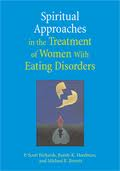
Reviewed by Garalynne Binford
Spiritual Approaches in the Treatment of Women with Eating Disorders was written by clinicians, all trained in psychology, at the Center For Change eating disorder treatment center in Utah. The writing is aimed primarily at experienced mental health practitioners working in the eating disorders field, with the hope that spiritual approaches will be incorporated and researched more in eating disorder treatment settings. Although I am a religious person, I have not had significant experience with spiritual approaches in eating disorder treatment. This book painted a clear picture of how the interplay between spiritual beliefs and eating disorders can be indispensable to recovery. I believe that if I were recovering from an eating disorder, I would want to have spirituality incorporated in my treatment.
The book was organized well, beginning with an introduction, theory and supporting research, moving into outlining a theistic spiritual framework, and then specifically and comprehensively describing the spiritually-informed treatment used at Center for Change. A brief basic introduction to eating disorders is provided, including the multi-disciplinary team (including a dietitian) in treatment, and then the majority of the book assumes a level of familiarity with eating disorder treatment. The primary focus is, as one would expect, on incorporating spiritual approaches into psychological therapy, with a strong emphasis on evidence and research. The authors review existing research as well as extensive suggestions for future research. Two information-packed chapters report data from the authors’ own outcome study, which appeared well-designed.
Although there was very little information related to food or eating, per se, lots of practical suggestions for treatment were discussed. Two concepts particularly struck me as useful. One concept was the heart, or core spiritual self. Getting patients to tune in with their heart can help them make decisions that are most congruent with their spiritual beliefs. Another concept was miracles. Asking patients to actively look for (and expect) miracles in their lives can help patients have a more tangible experience of their spirituality. The last section, Case Reports and Patient Perspectives, was especially meaningful to me. The authors provided several detailed accounts of spirituality influencing (and largely accounting for) their own patients’ recovery in a wide variety of circumstances, including results of qualitative studies that were performed. The recovered patients’ own accounts of the role of spirituality in their recoveries were hugely inspirational.
I would definitely recommend Spiritual Approaches in the Treatment of Women with Eating Disorders to anyone offering psychological therapy in eating disorders, and certainly to anyone with an interest in spirituality or religion. Although many eating disorder dietitians will find the content not readily applicable to their work, it will provide reassurance that helping patients nourish themselves can be part of those patients’ spiritual journey. When I had finished reading this book, I found myself wanting to read a book on the same topic directed toward patients. It would be lovely to see something like that in the future.
Spiritual Approaches in the Treatment of Eating Disorders is available for $59.95 through Gurze Books at http://www.bulimia.com/productdetails.cfm?PC=1475.
